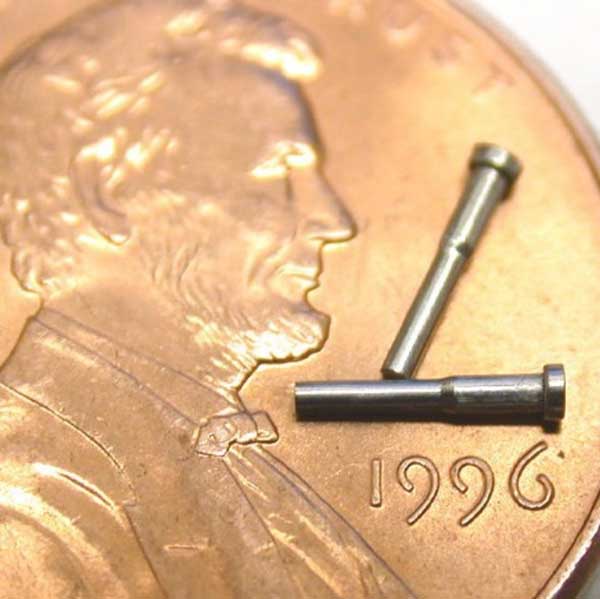
Manufacturers are constantly looking to reduce or maintain production costs without sacrificing quality. This leads them to examine all options, often with a focus on production processes. This is where cold forming comes in as an efficient alternative to Swiss machining.
Switching can offer impressive cost benefits, particularly for larger production runs. As a bonus, the cold forming process results in components with improved quality and strength when compared to machining. Let’s take a closer look at cold forming, its benefits, materials and what type of parts qualify.
Understanding Cold Forming
Cold forming, also known as cold heading, is a metal forming process performed at room temperature where material is shaped through plastic deformation without removing any material. Unlike Swiss machining, which cuts away material to achieve the desired shape, cold forming reshapes the metal through controlled pressure and flow.
Cold Forming vs Swiss Machining
The fundamental difference is that cold forming is an additive, deformation-based process while Swiss machining is a subtractive, cutting-based process. This distinction leads to the significant cost and efficiency advantages of cold forming over traditional machining methods.
Material Compatibility and Advantages
Cold forming offers flexibility in material selection, with excellent properties when compared to those typically used in machining. Here are a few examples:
- 302HQ Stainless steel – isused instead of 303 stainless which is often use in machining, eliminating the need for lead or sulfur additives while maintaining formability.
- Pure nickel – which is typically challenging to machine due to its soft and gummy nature, can be consistently formed using this process.
- Oxygen-Free High Conductivity (OFHC) copper – can be used in its pure form, providing excellent conductivity without the need for additives.
Key Benefits of Cold Forming
For parts that qualify, cold forming brings many benefits over machining. These include:
Material Savings – The process utilizes raw material in wire form that fits precisely into the die, maximizing material efficiency and minimizing waste. This is in sharp contrast with Swiss machining and the messy, wasteful chips that are generated in the process. This advantage becomes particularly valuable when working with precious materials, where every gram saved contributes directly to cost reduction.
Enhanced Production Efficiency – Cold forming dramatically accelerates production, achieving speeds up to 20 times faster or so than traditional Swiss machining methods. Some components can be produced at rates as high as 200 pieces per minute, significantly reducing production time and labor costs. The superior surface finish achieved through cold forming often eliminates the need for secondary operations, further streamlining manufacturing and reducing cost.
Improved Product Characteristics – The cold forming process inherently enhances the structural integrity of components through work hardening, resulting in stronger parts.
Parts emerge with a surface finish free from machining marks, meeting demanding aesthetic and functional requirements. The process creates excellent features, ensuring consistent part-to-part quality that often exceeds that of machined components.
Cost Effectiveness – Companies implementing cold forming typically experience reductions in raw material costs due to the elimination of waste. The significantly higher production rates drive down per-piece costs, while reduced secondary operation requirements further contribute to cost savings. Organizations also benefit from lower tooling maintenance costs and virtually eliminated scrap rates, creating a compelling financial advantage over traditional machining methods.
Practical Applications
Cold forming excels in producing a diverse range of components for many industries. Let’s look at a few examples:
- For Electronics, forming is used for manufacturing electronic contacts, pins, terminals and other components that require precise dimensions and excellent conductivity.
- Automotive manufacturers rely on cold formed components for their durability and cost-effectiveness
- Medical device manufacturers benefit from the process’s ability to produce high-precision, contamination-free components.
The approach proves equally effective in producing fasteners, rivets, high-current electrical contacts, and even micro-manufactured parts at the sub-millimeter scale for a wide range of applications.
Understanding the Limitations
While cold forming offers numerous advantages, certain limitations must be considered:
Geometric Constraints – since the process of forming vs machining is very different, there are part geometry limitations. For example,the ratio of head to shank volumes must be carefully evaluated to ensure successful forming. Also, punch depth capabilities impose certain restrictions on feature depth. Length-to-diameter ratios must remain within specific parameters to prevent tool buckling during formation. Edge features typically require some radius due to the natural flow characteristics of the material during forming.
Design Considerations – Converting parts to cold forming may necessitate certain design modifications to ensure manufacturing success. For instance, engineers must also avoid sharp corners that could lead to crack propagation in the formed part. Internal features must be designed within the constraints of material flow patterns, often requiring careful analysis and optimization.
Does Your Part Qualify?
When evaluating whether to convert from Swiss machining to cold forming, manufacturers should consider several critical factors as follows:
- Production volume requirements play a crucial role in determining economic feasibility.
- Material specifications must align with cold forming capabilities.
- The geometric complexity of the part needs careful evaluation against process limitations. Dimensional tolerances must fall within achievable ranges.
- Surface finish requirements must match the capabilities of the cold forming process.
Leading manufacturers such as Deringer-Ney, support the conversion process with comprehensive R&D capabilities. Their engineering teams conduct detailed sectioning analysis to verify part integrity. They also evaluate grain structure to optimize material properties. Material flow patterns receive careful analysis to prevent defects. When necessary, they provide design modification recommendations to ensure manufacturing success.
The transition from Swiss machining to cold forming can offer substantial cost benefits through material savings, increased production speeds, and shorter production cycles. While not every part is suitable for cold forming, the process’s advantages make it worth considering for many applications, particularly in high-volume scenarios. Working with experienced manufacturers who offer comprehensive engineering support will help ensure a successful conversion process.
Want to see if your parts and bottom line can benefit from Cold Forming? Contact us today.
